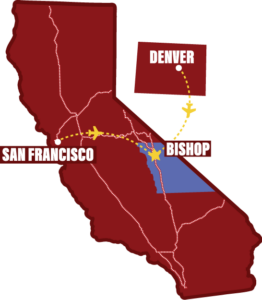Field Guide to Aquatic Stream Insects of the Sierra Nevada

… and why they’re so important!
June in the Eastern Sierra is “take a kid or friend fishing” month. Our big backyard is the perfect place to teach your youngsters and friends about fishing. Besides the fresh mountain air, wide open spaces, crystal clear streams and deep blue lakes, there are some very good reasons why fishing in the Eastern Sierra is so great.
River health is one very important factor in the life and times of the fish that run these waters. It may seem obvious that healthy rivers provide good conditions for healthy fish. What makes a river healthy may not be so obvious.
Many flyfishers are familiar with the wide variety of aquatic insects in the Sierra Nevada and these unique harbingers of stream health are a major contributor to the health of streams and rivers.
Stream environments can be divided into two major habitat types:
Riffles – which are shallow rocky areas with swift currents, and
Pools – which are deeper areas often at stream bends where currents are slower, particles settle out and deposits of sediment, leaves and wood accumulate.
The Herbst Lab, at the Sierra Nevada Aquatic Research Laboratory (SNARL), has been studying the health of aquatic ecosystems since 1986. In a recent publication of the Friends of the Inyo Magazine, the Jeffrey Pine Journal, the lab published a field guide to aquatic stream insects.
Here with kind permission of The Herbst Lab is a field guide to 6 aquatic invertebrates that are vital to the health of our streams and rivers.
6 Aquatic Stream Insects
The aquatic invertebrates pictured here are all immatures. They go through development, molting their skin or cuticle as they grow. Nymphs are those that become very similar looking adults, just sprouting wings, while those know as larvae go through a complete metamorphosis where the adults look very different (as a butterfly to a caterpillar).

Duroneuria
Known by the common name as the golden stonefly, this is a large active predator (2-3”) that searches like a tiger for prey. The nymphs live only in cold turbulent riffle habitats and live for several years before maturing into winged adults. They are indicators of good habitat quality and an important food source to fish.
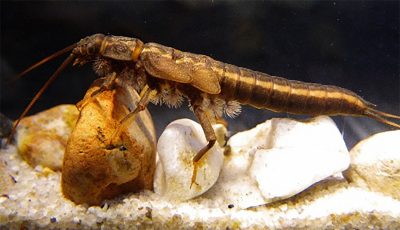
Pteronarcys
The California salmonfly (2-3”) is another large stonefly that develops over multiple years. It is also a good indicator of quality habitat and important in food webs. Frequently found around large submerged rocks where packs of leaves often get stuck on the upstream side of rocks. With an eating style known as a shredder, it eats the decomposing leaves and wood.

Tipula
The crane fly larvae (1-3”) often live in pools and are also consumers of decaying leaf and wood matter. It develops into large long-legged true flies (order Diptera), sometimes called Mosquito hawks. These fragile insects do not eat mosquitos, feeding little if at all during their short adult life span. The larvae, sometimes known as leather jackets, store enough nutrition after multiple years of growth for the mated adult female to develop eggs.
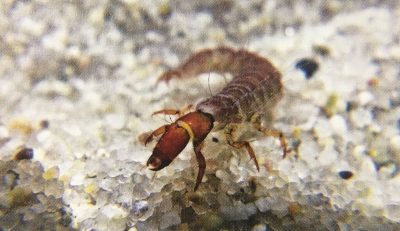
Rhyacophila
The primitive mountain caddisflies (0.5-1”) are all predatory and common in cool streams at moderate to high elevation, and are a diverse genus of many species. Unlike most other caddis that build portable cases of sand grains or plant material, these caddis larvae are free-living cruising for prey in unpolluted streams.
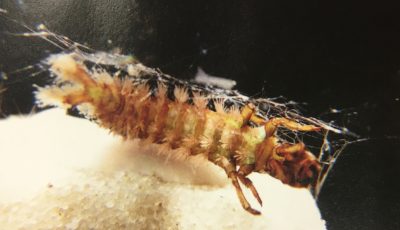
Arctopsyche
Net-spinning caddisflies (0.5-1”), known to fly fishing as the great gray spotted sedge, use silk to build a fixed retreat on rocks where larvae position themselves to collect drifting food particles in a mesh net they spin at an opening in the case they build. As with caterpillars that spin silk, the material is quite strong, resisting the currents where capture of food particles is most productive. Like butterflies, the adults have scales on their wings, looking somewhat like moths. They act as ecosystem engineers in streams, building structures and filtering suspended food particles.

Cinygmula
These mayfly nymphs are small (0.2-0.5”), often sprawled on rock surfaces whwere their flattened bodies permit them to move easily in fast water, and where they can graze or scrape off thin films of algae for their food. Known as dark red quills in fly fishing jargon, these nymphs live just a year or less and only very briefly as diaphanous adults. As with the insects above, they are integral to the food web of streams and their presence shows a healthy environment.
Earth Day & Education
Kids love bugs! At the recent Earth Day celebrations at the Bishop City Park, the guys from Herbst Lab had a wonderful display of insects and a fun “petting zoo”. Educational information and results from their research is available online at The Herbst Lab.

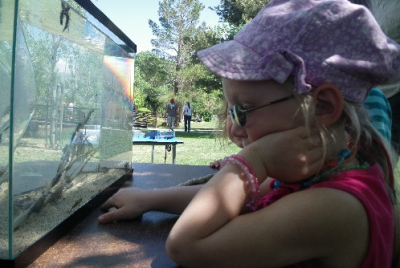
“Science is only powerful when shared.” – The Herbst Lab.
Take a Kid or Friend Fishing
When you head out to the river or up into the mountains take a child, a friend, a family member and share the love of fishing in the Eastern Sierra. Take a look into the streams and pools and see if you can spot these amazing little creatures that make fishing in the Eastern Sierra the rewarding experience that it is.



